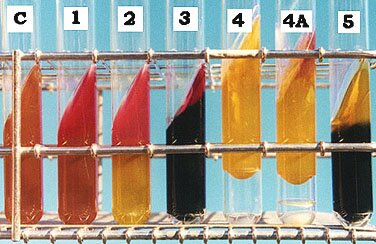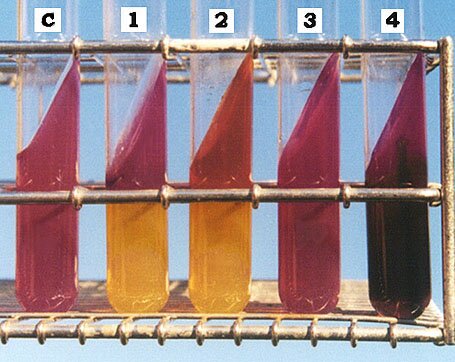Overview of Differential Features of TSI and LIA
| |
Triple Sugar Iron (TSI) Agar |
Lysine Iron Agar (LIA) |
| source of amino acids which may be deaminated (alkaline rx.) |
peptone,
proteose peptone,
beef extract,
yeast extract |
peptone,
yeast extract,
lysine |
| amino acid added to note its decarboxylation (alkaline rx.) |
none |
lysine |
| fermentable sugar(s) (acid rx.) |
lactose (1%),
sucrose (1%),
glucose (0.1%) |
glucose (0.1%) |
| pH indicator |
phenol red:
net acid = yellow,
net alkaline = red |
brom-cresol purple:
net acid = yellow,
net alkaline = purple |
| source from which H2S may be produced |
sodium thiosulfate |
sodium thiosulfate |
| indicator of H2S production |
ferrous sulfate |
ferric ammonium citrate |
Triple Sugar Iron (TSI) Agar
Note the relative amounts of sugars in TSI Agar according to the table seen above. By the degree of acid produced from fermentation, differentiation can be made between non-fermenters, glucose-fermenters (which produce a relatively small amount of acid) and those which ferment lactose and/or sucrose in addition to glucose (producing a relatively large amount of acid which diffuses througout the medium and easily overneutralizes the aerobic deamination reaction in the slant). Organisms which produce hydrogen sulfide from the reduction of thiosulfate are easily detected; the H2S reacts with the iron in the medium to produce ferrous sulfide, a black precipitate. The medium is inoculated with the needle, first stabbing down the center to the bottom of the tube and then streaking up the slant. Incubation is for one day at 37°C. The various combinations of reactions are explained and illustrated below. (Tube "C" is the uninoculated control tube which shows an orange (neutral) reaction throughout.)
 |
| corresponding tube no. above |
1 |
2 |
3 |
4* |
5** |
| deamination of amino acids (aerobic alkaline rx.) |
+ |
+ |
+ |
+ |
+ |
| glucose fermentation (minor acid rx.) |
– |
+ |
+ |
+ |
+ |
| lactose and/or sucrose fermentation (major acid rx.) |
– |
– |
– |
+ |
+ |
| H2S production (black color) |
– |
– |
+ |
– |
+** |
| typical examples |
Pseudomonas
(a non-enteric) |
Morganella,
Providencia,
Shigella |
Citrobacter,
Salmonella,
Edwardsiella |
E. coli,
Enterobacter,
Klebsiella |
sucrose+ Proteus,
coliform strains of
Citrobacter that are H2S+,
H2S+ E. coli,
lactose+ Salmonella,
Edwardsiella tarda Biogroup 1 |
* Tube 4: Much gas is often seen for this tube, evidenced by cracks in the medium. Also, methyl red-negative organisms which ferment lactose and/or sucrose may show a "reversion" toward an alkaline reaction as neutral products are formed from some of the acid. Note the slight orange to red color at the tip of the slant in tube 4A. How might such a tube look at two or more days of incubation? (Regarding the methyl red test, recall the activities of enterics in MR-VP Broth which are illustrated here.)
** Tube 5: It should be noted that an excessive amount of acid from lactose and/or sucrose fermentation may be produced such that the black iron sulfide precipitate will break down and not be seen. In this case, the tube will look like tube 4. |
Lysine Iron Agar (LIA)
Here is another multipurpose medium in one tube. Reactions for lysine decarboxylation (anaerobic alkaline reaction – overneutralizing the acid formed from glucose fermentation), lysine deamination (formation of red-colored products at the top of the medium) and H2S production (black precipitate) can be made as seen and explained below. (Tube "C" is an uninoculated "control" tube showing the neutral, purple color.)
 |
| corresponding tube no. above |
1 |
2 |
3 |
4* |
deamination of amino acids
(aerobic alkaline rx.) |
+ |
+ |
+ |
+ |
deamination of lysine
(dark red slant) |
– |
+ |
– |
– |
decarboxylation of lysine
(anaerobic alkaline rx.) |
– |
– |
+ |
+ |
glucose fermentation
(acid rx.) |
+ |
+ |
+ |
+ |
typical examples
|
Citrobacter |
Proteus
Providencia
Morganella |
E. coli
Enterobacter |
Salmonella
Edwardsiella |
| * H2S-positive reaction usually seen for Salmonella and Edwardsiella is shown for Tube 4. LIA is not as reliable an indicator of H2S as are KIA and TSI. |
|

